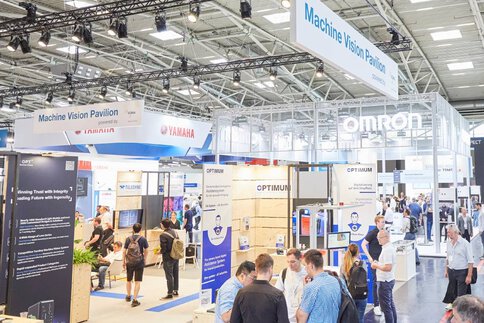An interface between photonics and automation
In highly automated process worlds, industrial image processing plays a key role. The jointly organized Machine Vision Pavilion from LASER World of PHOTONICS and automatica provides a new platform for the technology.
When modern printing machines are operating at full speed, they can print around 20,000 large-format sheets of paper per hour with the highest level of quality and the finest resolution. In web-fed printing, hundreds of meters of paper per minute run through more than a dozen printing and coating units as well as drying. Human senses cannot keep up with speeds such as these. That’s why camera systems are increasingly used from prepress to finishing of printed sheets and rolls. They detect even the smallest errors in print templates—from missing i-dots to minimal color deviations—and also monitor quality in the incredibly fast printing process. This enables printers to stop faulty processes immediately. If the defect in the process can be remedied, the inspection systems document precisely which sections of a roll or which sheets are affected. These are specifically sorted out while the unaffected part of the print production can continue to be processed.
This principle—in-line camera-based quantity control to take immediate action in case of defects and to sort out the affected sections—is becoming increasingly popular where production is highly automated. After all, each processing step increases the value of the finished products. And the later in the process the defects are identified, the greater the loss of resources, energy, and time.
Photonics and automation are closely interwoven
These days, with the help of modern camera systems and optimum illumination, it is possible to monitor very complex, rapid production processes in line. The image sensors of the cameras and processors of the computers that process their image data are now so powerful that data lines have literally become a bottleneck. Optical data transmission could be the answer. The increased performance of the image sensors and processors can already be attributed to photonic and, naturally, fully automated high-end production methods in the semiconductor industry. These are also monitored in-line by optical sensor systems that are controlled by nano-positioning systems to check wafers for defects and faults in the sub-nanometer range. Only in this way is it possible to fit over a trillion transistors without errors on a single chip, whose structure sizes are now in the single-digit nanometer range thanks to EUV lithography.
These few examples illustrate just how closely optical sensor technology, precise illumination, and photonic manufacturing processes together with the increasing automation of modern industrial processes are interwoven. As well as being used for in-line quality control, camera systems also have the task of giving robots and machines visual orientation. This machine vision is a key pillar of Industry 4.0.
Machine Vision Pavilion
Because machine vision is at the interface between photonics and automation and there are plenty of overlaps between the players in both industries, the co-location of LASER World of PHOTONICS and automatica, the leading trade fair for intelligent automation and robotics, will open up many fascinating synergies. While LASER, the leading trade fair for photonics components, systems and applications, brings leading providers of camera systems including sub-systems and peripherals (such as image sensors, optics, illumination solutions, nano-positioning technologies and optical measurement technologies) together with suppliers of photonic manufacturing solutions, automatica extends the group of trade visitors with leading players in the robotics and automation industries and their mainly industrial customers. As a result, the leading trade fairs, which, for the first time, will be held simultaneously at the Munich trade fair center from June 27 to 30, 2023, will present the entire machine vision chain: from image sensors through to system integration in the smart factory of the future.
This wide range of products can be found in the joint Machine Vision Pavilion of LASER and automatica in Hall B5 with the focus on industrial image processing, sensor technology and robotics. In June there will be another premiere: the VDMA with its Machine Vision sector group, which represents more than 120 companies in this industry, will help organize the pavilion. The new platform will be rounded off by an interactive presentation concept. The Vision Expert Huddles introduce trends in industrial image processing technology via short keynote presentations and provide an opportunity to network with the speakers. For each exhibitor at the Machine Vision Pavilion, a presentation slot will be scheduled for this purpose, enabling them to present their offerings and expertise outside their booths and to enter into a dialog with the international visitors to the two trade fairs.
Information regarding registration and the terms and conditions can be found on the Machine Vision Pavilion website.

